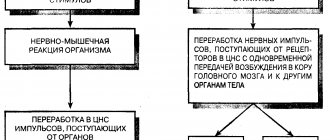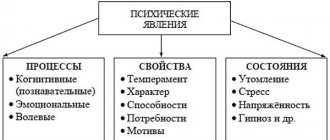Concept and stages of formation
Feelings are often confused with emotions.
These phenomena of the human psyche are interrelated, but are not interchangeable. Feelings are a special form of a person’s relationship to the world around him, which arises as a response to compliance or non-compliance with current needs. They are distinguished by their stability and strength of manifestation. With their help, an individual expresses his attitude towards people, phenomena, objects, and denotes beliefs and character traits. A sensory reaction occurs in response to an event occurring in an individual's life. Correct formation of reactions is necessary for the development of a harmonious, healthy personality. This is an individual process that begins in early childhood. The formation is influenced by the family environment and local culture. In Spain it is customary to express feelings violently, but in Japan this is a sign of poor upbringing.
Feelings are usually divided into lower and higher. The lower ones include physiological manifestations: hunger, fatigue. The highest include manifestations associated with the spiritual world: admiration, empathy, emotional attachment. The presence of higher feelings distinguishes humans from animals.
Sensory experiences have an object reference. An individual cannot experience them for a situation or phenomenon, only for a specific character or object. Feelings may not have external manifestations: while living them inside, the individual remains calm outwardly. They are often nonverbal—unspoken.
Fleeting manifestations occur when interaction with an object has been brief. To form a stable connection, you need long-term contact. This is exactly how falling in love develops: if a person is deprived of the opportunity to see the object of adoration, falling in love quickly passes. If he can look at least at a portrait every day, then love will only be nourished and strengthened.
Basic emotions
Most psychologists (including the American Carroll Izard, who proposed this classification) include the following as the main, most common emotions:
- Joy/pleasure . This is a positive emotion that creates a good mood and a positive emotional background. Joy appears in a person when he has the opportunity to satisfy an important need (plan, desire). Emotion has a positive effect on a person’s communication skills, increases self-confidence, and relieves stress and anxious thoughts.
- Interest . A feeling that is closely related to a person’s sociality. Only thanks to him it becomes possible to acquire new knowledge, skills and abilities, physical and mental development of the individual.
- Astonishment . An emotion arises as a reaction to an unexpected event or action. It cannot be classified as either a positive or negative emotion, since surprise can be both pleasant and have a negative connotation.
- Sadness/suffering . Suffering is a negative emotion that arises due to the fact that a person cannot get what he wants or satisfy his needs. Sadness causes loss of strength and apathy.
- Anger/anger . This is a negative emotion that arises from the inability to get what you want, failure, or dissatisfaction with someone's behavior. Anger may well lead to an affective state.
- Guilt . This is a negative reaction that arises as a result of judging oneself: one’s behavior, words, thoughts. Following guilt, a person often experiences remorse.
- Fear . A negative emotion associated with awareness for one’s own life or the lives of loved ones. In this case, the threat can be both real and far-fetched.
- Contempt . It is a negative reaction to another person's behavior or words that stems from deep differences in people's beliefs.
- Disgust . It arises as a negative reaction to an object, actions, events or phenomena that contradict the moral, aesthetic or ideological views of the individual.
- Shame . A negative emotion that arises as a result of a discrepancy between one’s appearance or behavior and the expectations of other people or oneself. Quite often, shame is accompanied by a feeling of helplessness.
Age stages of development
The development of feelings in early childhood is an important, complex process. It happens in stages:
- Newborn baby. Once born, a child masters the basic forms of manifestations necessary for survival: hunger, pleasure, pain, fear. The emotional state depends on physical sensations. A newborn does not know how to distinguish between feelings. His main interest and need is physical contact with his mother. The baby reacts to her mood and copies it.
- From 0 to 6 months. The baby understands what sensations he experiences when in contact with adults. His perception is fragmentary: he sees the world in parts. By six months, he learns to distinguish between family and strangers; anxiety and wariness appear in his arsenal. While exploring the world, he tries to touch everything he sees. If this fails, the baby experiences anger and discomfort.
- 6–12 months Six-month-old babies know how to be surprised and show interest. In addition to physical needs, the child has mental ones. Interests gradually form: the child divides toys into favorites and unloved ones. At the age of 8 months, fear of separation from the mother appears, the child experiences anxiety and becomes restless.
- 1–1.5 years. Own desires appear, the need to realize them. The child learns to make independent decisions, but often faces prohibitions from adults. An obstacle causes anger and a desire to get what is yours. At this age, it is important to learn to separate desires and actions. The main achievement of 1.5 years is that the child develops an idea of himself, the baby identifies himself with his name.
- 1.5–2 years The child is no longer helpless. He moves confidently, can pick up a toy himself, and has more freedom and needs. He strives to prove independence, the right to his own opinion. At this age, he already shares feelings, but cannot name them.
- 2–2.5 years Two-year-old children see themselves as the center of the world; they have no understanding of danger. Also, the feeling of compassion and pity has not yet been formed: if the child does not like another baby, he may hit him or bite him, expressing hostility.
- 2.5–3 years. With successful development, by the age of three the child will have formed a holistic idea of himself. There is pride in one’s independence and shame in case of failure. Interest in other children awakens, the desire to take their place in the team.
The development of feelings continues until the end of adolescence. The first years of life form the foundation that will help a child differentiate feelings from emotions.
Adaptation of a child in a team
Psychological self-regulation
Psychological self-regulation is a set of methods for managing one’s own mental state. The subject influences himself using willpower. With the help of psychological self-regulation techniques, you can easily achieve the desired result.
Effects of psychological self-regulation:
- Calmness is achieved after the elimination of emotional tension.
- Recovery begins after complete calm and quality rest.
- Activation - begins with an increase in psychophysiological activity.
Methods of psychological self-regulation are divided into two large groups:
- Natural - occur on their own, without a specific purpose.
- Directed - used by a person to achieve a certain mental state.
Natural:
- sleep, food;
- interaction with animals and nature;
- massage, dancing;
- music, entertainment.
Available methods of psychological self-regulation:
- Laughter, smile, humor.
- Contemplation of panoramas, landscapes.
- Concentrating on pleasant things, for example, on your favorite flowers, old photographs.
- Breathing fresh air.
- Thinking about the good.
- Muscle relaxation.
- Expressing praise and compliments.
Many aspects of his life depend on a person’s emotional state. It is impossible to work productively when you are in a bad mood, depressed, or stressed. It’s easier to achieve your goal in a good mood
It is important to learn to control your own emotional state and know how to get out of stress correctly.
Qualitative characteristics
Feelings have characteristics that distinguish them from other emotional manifestations:
- Valence - division into positive, negative and ambivalent (dual). The occurrence of ambivalent manifestations speaks of rich life experience and lack of categoricalness. Ambivalence is characteristic of people with a high level of intelligence.
- Intensity is the power of manifestation. By intensity, one can determine the main and secondary feelings, assess a person’s ability to self-control, and the development of willpower.
- Content is the meaning for a person of an object in relation to which he shows feelings.
- Sthenicity is an urge to action, a desire to express a feeling. If a person tries to restrain manifestations, this is called asthenicity.
The intensity of the manifestation of feelings determines the behavior of the individual and the attitude of other people towards him. Emotions are always sincere, and the demonstration of feelings can be planned in advance.
Application of the Abraham Hicks scale to assess the condition
To create an accurate psychological description of a person’s emotional states and identify disturbances in the emotional sphere, you can use the Abraham Hicks scale. It can be used to describe a wide range of feelings - from negative to positive. Feelings on the scale are divided by color.
It is important to remember the feature of the scale. It is impossible to move along the scale from one side to the other without passing through intermediate stages
For example, it is impossible to go from suffering immediately to joy. Colors go from red to purple. The neutral zone, which is located in the center, is indicated in green.
Red zone
Manifestations:
- hopelessness;
- impotence;
- depression;
- despair;
- uncertainty;
- bitterness;
- envy;
- misfortune;
- humiliation;
- fear;
- shame;
- abandonment.
To move through the negative zone, you need to experience negativity, try to express it in order to move towards positive emotions.
Orange
The orange zone is less negative, but the sensations remain bad:
- fright;
- detachment;
- indignation;
- undervalued;
- anger;
- revenge;
- guilt;
- mistrust;
- resentment;
- hatred;
- discouragement.
It is important to be patient when navigating the different zones of the scale. To get rid of negative feelings, you can use natural psychological defense mechanisms, for example, shifting the blame to others
This helps to free yourself from negativity.
Yellow
This is an area of disappointment. Feelings:
- anxiety;
- sadness;
- disappointment;
- irritation;
- doubt;
- self-pity;
- loneliness;
- depression;
- anxiety;
- regret.
When passing through this and the next zone, psychologists recommend retuning to positive thoughts.
Green
Neutral zone. The main manifestation is boredom. Feelings become mixed as there is a transition between positive and negative emotions. The subject is unable to accurately describe his condition. He's not good, but he's not bad either. To him:
- boring;
- empty;
- Fine;
- indifferent.
At this stage, it is important to relax and try to renounce any feelings. You will feel temporarily tired
The person does not know what to do next. The main thing is not to give in to negativity. You need to try to rest.
Blue
At this stage, the subject begins to have hope. Characterized by:
- trust;
- value;
- nobility;
- fun;
- acceptance;
- interest.
Blue
With each stage the feelings will get better. At this stage, self-confidence appears. Her goal is to move from hope to faith
It is important to have the right mindset so that only good things happen. The blue zone is characterized by:
- confidence;
- approval;
- respect;
- anticipation of interesting events.
At this level a person feels security and satisfaction. He develops enthusiasm and strength to achieve his goals.
Purple
The last zone is purple. This stage is characterized by a feeling of invincibility. To feel global positive changes, you need to stay in this zone for at least three days in a row. If this condition persists for a month or more, your life position and train of thoughts will change. Most likely, material changes will occur - changing jobs, moving to a new place of residence, moving up the career ladder.
Functions and meaning
The task of the senses is to receive and classify information about objects. They also have separate functions:
- reflective - helps to assess the level of danger and usefulness of objects in order to respond to the threat in time;
- stimulating - encourages you to take active actions, make plans for the future, look for ways to solve complex problems, motivation;
- reinforcing - helps to assess the significance of an event for an individual, to remember important things;
- switching - tells you which category to classify objects, actions into, and set priorities;
- adaptive - forms a ready-made base of manifestations that a person has already experienced;
- communicative - affects relationships with others, the need for communication, helps to establish emotional contacts.
Only a positive social environment can ensure normal functioning of functions. If a function malfunctions, a person’s emotional intelligence does not develop. A low level of emotional intelligence is characteristic of children who were raised in a disadvantaged environment.
An extreme degree of manifestation of pedagogical neglect in Mowgli children who grew up away from people. They do not distinguish between the manifestations of other people and do not know how to express feelings. Their psychological development is at the level of a baby monkey.
Classification by types and scope of manifestation
Feelings are varied and sometimes a person cannot explain what he is experiencing. To simplify the assessment process, you should use the classification of types of feelings in psychology:
- Subject - refer to the basic spheres of human reality. They show reactions to various actions of others: irritation, delight, surprise, anger.
- Intellectual - desire for new experiences: curiosity, anticipation, doubt.
- Aesthetic - a reaction to beautiful, ugly objects: experiences of admiration, disgust, pleasure, dissatisfaction.
- Praxic - associated with the choice of activity. They determine the attitude towards responsibilities: determination, thirst for knowledge, satisfaction.
- Moral - responsible for the interaction of people, personal assessment of what is permissible and unacceptable: patriotism, love, cruelty, selfishness.
Complex feelings cannot be classified into one category; they are always a combination of 2-3 different experiences. For example, love can encourage one to gain knowledge, change activities, and unlock potential. Resentment can cause irritation, despair, and apathy.
A large list of a person’s emotions and feelings/experiences. 257 emotions in alphabetical order
Excitement Apathy Serenity Hopelessness Harmlessness Safety Indifference Hopelessness Anxiety Helplessness Incoherence Powerlessness Fury Reverence Gratitude Bliss Vigor Soreness Pain Fear Rebellion Inspiration Generosity Faith Mutual assistance Excitement Guilt Falling in love Excitement Indignation Belligerence Excitement Receptivity Delight Delight theft Sensitivity Temperance Arrogance Stupidity Anger Pride Arrogance Bitterness Willingness Sadness Disorientation Depression Insolence Kindness Trust Contentment Annoyance Drive Friendliness Competitive spirit Heartache Pity Liveliness Funniness Caring Envy Surrender Interested Ingratiation Confusion Arrogance Confusion Shyness Schadenfreude Anger Identity Isolation Amazement Interest Irony Sincerity Fear Hysteria Exhaustion Comfort Laziness Jubilation Cunning Admiration Love Self-love Curiosity Dream peacefulness Peacefulness Plea Gloominess Vengefulness Hope Arrogance Tension Alertness Equanimity Indignation Tenderness Awkwardness Unsociability Hatred Disobedience Dislike Nervousness Impatience Inconvenience Discouragement Concern Resentment Relief Relief Adoration Doom Loneliness Spirituality Liveliness Waiting Concern Puzzle Mischief Disgust Fear Optimism Devastation Liberation Insult Stunned Caution Disgust O haste Detachment Retardation Detachment Despair Alienation Appreciation Numbness Fascination Fascination Dazed Dazed Feeling trapped Feeling stuck Feeling threatened Sadness Tearfulness Dejection Obsessiveness Trick Suspicion Suspiciousness Abandonment Submissiveness Patronizing Insanity Defeat Impulse Lost Shock Superiority Anticipation Contempt Disregard Affection Appreciation Acceptance Elation Forgiveness Inquisitive Joy Irritation Frustration Vulnerability Disposition Absent-mindedness Relaxation Frustration Confusion Jealousy Reflection Determination Zeal Self-righteousness Self-worth Sarcasm Grumpiness Restraint Sentimentality Angry Seriousness Strong desire Sympathy Sorrow Boredom Weakness Brokenness Laughter Humility Confusion Confusion Composure Regret Doubt Resistance Sympathy Calm Shyness Suffering Passion Fear Longing Stress Shame Happiness Firm confidence Warmth Longing Anxiety Trembling Three umf Heaviness Respect Self-confidence Passion Passion Dejection Sullenness Luck Surprise Satisfaction Pleasure Dejection Horror Remorse Tenderness Peaceful Humiliation Humiliation Despondency Loss of strength Persistence Fatigue Injured Vulnerability Blues Royalty Cynicism Feeling of lack of love for you Shock Euphoria Exaltation Ecstasy Energy Enthusiasm Rage
Effect on mood
In psychology, mood is an emotional state at a specific moment in time. Mood is rarely accompanied by a strong emotional reaction, but affects all activities. It creates a background that determines the speed and efficiency of work. Normally, the mood is stable. In individuals with a strong nervous system, it changes less frequently; in sensitive people, the change occurs frequently.
The mood has a pointless character. Even if a person understands what specifically caused dissatisfaction, the bad mood spreads to activities and relationships. Mood affects feelings. In a bad mood, people experience irritation and injustice towards themselves. In a good situation, they are ready for selfless actions, a favorable attitude towards an unpleasant person.
Feelings derived from the 4 basic emotions
Psychologists believe that the whole variety of feelings is built around 4 basic emotions, from which others originate. This:
- fear;
- sadness;
- anger;
- joy.
Fear
Often people have far-fetched reasons for its occurrence, but the intensity and strength of the emotion do not depend on the rationality of what is happening.
Under the influence of fear, a person is born with other negative emotions:
- horror;
- fright;
- anxiety;
- anxiety;
- despair;
- suspicion;
- confusion;
- doubt;
- numbness.
Sadness
Derivative feelings from sadness are:
- bitterness;
- yearning;
- sorrow;
- despair;
- helplessness;
- hopelessness;
- disappointment;
- shock;
- regret;
- sadness;
- grief.
Anger
Other manifestations of anger may include:
- anger;
- rage;
- rabies;
- irritation;
- hatred;
- indignation;
- resentment;
- contempt;
- hostility;
- envy;
- annoyance;
- disturbance;
- disgust.
Joy
A person’s feeling of joy can lead to the formation of similar emotional states:
- happiness;
- delight;
- euphoria
- excitation;
- hope;
- Delight;
- satisfaction;
- tenderness;
- Love.
Similarities and differences with emotions
Emotions and feelings in psychology have an inseparable connection: they form the emotional background. Often the individual does not see the difference between them. But they differ in duration, depth, and degree of manifestation.
Feeling is a person’s deep, stable attitude towards an event or phenomenon. It is often hidden, it can be consciously suppressed, masked. Containing emotions is more difficult. They appear as a short burst, a fleeting reaction. Emotions manifest themselves unconsciously. Feelings are conscious manifestations aimed at a specific goal. Emotions can be experienced without external stimulus. For example, an individual experiences strong emotional excitement when listening to music or watching a movie. He empathizes with fictional characters.
When experiencing emotions, a person gives a subjective assessment of what is happening. It depends on the characteristics of his nervous system: phlegmatic people are low-emotional, and choleric people find it difficult to restrain themselves. Sanguine people easily experience strong emotions, but they cause inconvenience to melancholic people. It is impossible to change the characteristics of the nervous system, but you can learn to control emotions. To do this, an individual must distinguish between emotions and feelings and not be afraid of the negative spectrum of emotions.
Types of feelings
Higher feelings
The emergence of these feelings is based on the satisfaction or dissatisfaction of spiritual needs . (Lower feelings are associated with organic needs, such as sleep, food, water, comfortable temperature and others). Higher feelings are closely related to social character , socializing and developing personality. The manifestation and direction of higher feelings are individual for everyone, depending on their worldview, internal principles, moral standards, and aesthetic assessments. Thanks to the development of higher feelings, a person becomes moral, responsible and worthy, and can show love and gratitude.
Moral feelings
The basis of moral feelings is a person’s understanding of not only personal goals and interests , but also the interests of the team, organization, state, people. This type of feeling includes patriotism, duty and responsibility to others, and collectivism .
Moral feelings are deep feelings of duties to people not based on scientific knowledge and judgment.
If for an individual the success of his nation causes delight, the success of the team pleases no less than his own, then the person has developed moral feelings at a high level. Let us give an example of such a moral feeling as a sense of duty - the outstanding exploits of soldiers during the war, who at the cost of their own lives defended their Motherland and showed courage and dedication. But not only a sense of duty can manifest itself in wartime, but also in everyday life. For example, it is thanks to a sense of duty that a student does his homework , refusing to watch a cartoon. A child may sacrifice playing with friends to care for a sick mother. You can also highlight such a moral feeling as conscience , which is directly related to self-assessment of one’s own actions and behavior. When performing a positive action, a person feels joy and moral satisfaction , he is completely confident in the correctness of his action. Another action can cause internal contradictions and lead to torment of conscience and moral dilemma.
Intellectual feelings
This type of feelings is directly related to the cognitive and intellectual activity of the individual . This is an expression of a person’s relationship to his own thoughts, the process of cognition and the results of intellectual work. Intellectual feelings include, for example a feeling of surprise when receiving unexpected conclusions, doubts about an ambiguous statement, a feeling of confidence in one’s views and conclusions, and a feeling of satisfaction from the work done.
Aesthetic feelings
These feelings are especially often experienced by people with a creative personality; these are feelings such as understanding of beauty, love of beauty .
The main source of aesthetic feelings is a work of art, such as theater, music, cinema, painting and others.
A person can also experience aesthetic feelings when contemplating nature, which are particularly profound.











